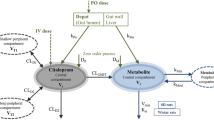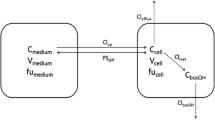Abstract
A pharmacokinetic model is presented to describe the biotransformation of 2-butanol (2-OL) and its metabolites (2-butanone, 3-hydroxy-2-butanone, and 2,3-butanediol) using in vivo experimental blood concentrations. A flow limited model is developed to simulate 2-OL, 2-butanone (2-ONE), 3-hydroxy-2-butanone (3H-2B), and 2,3-butanediol (2,3-BD) blood concentrations in rats after oral administration of 2-OL. Assuming the only important site of 2-OL biotransformation is the liver, the tissues included are the liver and a volume of distribution, essentially body water in the case of 2-OL and its metabolites. A distribution coefficient is found to be necessary to describe the low concentration of 3H-2B in blood after administration of 2-OL. The need for this coefficient may be due to partitioning, binding, or altered transport rates from the liver. Inhibition of 2-ONE metabolism to 3H-2B by 2-OL has been included to explain a time delay in the appearance of 3H-2B after administration of 2-OL. Subsequent experimental verification confirms the mixed function oxidase inhibitory properties of 2-OL. The model is able to simulate blood concentrations and elimination of all four compounds after the oral administration of 2-OL. Additionally, the model also simulates the results obtained after i.v. administration of 3H-2B and 2,3-BD.
Similar content being viewed by others
References
R. O. Recknagel. Carbon tetrachloride hepatotoxicity,Pharmacol, Rev. 19:145–208 (1967).
H. H. Cornish and J. Adefuin. Ethanol potentiation by halogenated aliphatic solvent toxicity.Am. Indust. Hyg. Assoc. J. 27:57–61 (1966).
G. J. Traiger and J. V. Bruckner. The participation of 2-butanone in 2-butanol-induced potentiation of carbon tetrachloride hepatotoxicity.J. Pharmacol. Exp. Ther. 196:493–500 (1976).
G. D. DiVincenzo, C. J. Kaplan, and J. Dedinas. Characterization of the metabolites of methyl n-butyl ketone, methyl iso-butyl ketone and methyl ethyl ketone in guinea pig serum and their clearance.Toxicol. Appl. Pharmacol. 36:511–522 (1976).
F. K. Dietz and G. J. Traiger. Potentiation of CCl4 hepatotoxicity in rats by a metabolite of 2-butanone: 2,3-butanediol.Toxicology,14:209–215 (1979).
K. B. Bischoff, R. L. Dedrick, D. S. Zaharko, and J. A. Longstreth. Methotrexate pharmacokinetics.J. Pharm. Sci. 60:1128–1133 (1971).
R. L. Dedrick and K. B. Bischoff. Thiopental pharmacokinetics.J. Pharm. Sci. 57:1346–1351 (1968).
K. J. Himmelstein and J. F. Gross. Mathematical model for cyclocytidine pharmacokinetics.J. Pharm. Sci. 66:1441–1444 (1977).
R. L. Dedrick, D. S. Zaharko, and R. J. Lutz. Transport and binding of methotrexatein vivo.J. Pharm. Sci. 62:882–890 (1973).
M. Virolaihen. Intravenous injections in small laboratory rodents.Transplantation 5:1530–1531 (1967).
T. Omura and R. Sato. The carbon monoxide-binding pigment of liver microsomes.J. Biol. Chem. 239:2370–2378 (1964).
M. Bradford. A rapid and sensitive method for the quantitation of microgram quantities of protein utilizing the principles of protein-dye binding.Anal. Biochem. 72:248–254 (1976).
P. Mazel. In B. N. LaDu, H. G. Mandel and E. L. Way (eds.),Fundamentals of Drug Metabolism and Drug Disposition, Williams & Williams, Baltimore, 1971, p. 549.
R. G. D. Steel and J. H. Torrie. InPrinciples and Procedures in Statistics, McGraw Hill, New York, 1960, p. 57.
A. Ralston and H. S. Wilf.Mathematical Models for Digital Computers, John Wiley & Sons, New York, 1960, pp. 95–109.
A. Ralston. Runge-Kutta methods with minimum error bounds.Math. Comp. 16:431–437 (1962).
J. Dawson and R. P. Hullin. Metabolism of acetoin. The formation and utilization of acetoin and butane-2,3-diol in the decerebrated cat.Biochem. J. 57:177–185 (1954).
M. A. Gabriel, H. Jabara, and U. A. S. Al-Khalidi. Metabolism of acetoin in mammalian liver slices and extracts. Interconversion with butane-2,3-diol and biacetyl.Biochem. J. 124:793–800 (1971).
I. A. Kamil, J. N. Smith, and R. T. Williams. The metabolism of aliphatic alcohols. The glucuronic acid conjugation of acyclic aliphatic alcohols.Biochem. J. 53:129–136 (1953).
L. Schwartz. Uber die oxydation des acetone and homologer ketone der fettsaurereihe.Arch. Exp. Pathol. Pharmakol. 40:168–194 (1898).
R. T. Williams. InDetoxification Mechanisms, 2nd ed., Chapman and Hall, London, 1959, pp. 95–97.
A. D. Merritt and G. M. Tomkins. Reversible oxidation of cyclic secondary alcohols by liver alcohol dehydrogenase.J. Biol. Chem. 234:2778–2782 (1959).
S. Kramer, H. Staudinger, and V. Ullrich. Effect of then-hexane inhalation on the monooxygenose system in mice liver microsomes.Chem. Biol. Interact. 8:11–18 (1974).
E. Mezey, Ethanol metabolism and ethanol-drug interactions.Biochem. Pharmacol. 25:869–875 (1976).
P. K. Gessner, D. V. Parke, and R. T. Williams. Studies in detoxication, the metabolism of glycols.Biochemistry 74:1–5 (1960).
W. Westfeld and R. Berg. Observations on the metabolism of acetoin.J. Biol. Chem. 148:523–528 (1943).
L. I. Harrison and M. Gibaldi. Physiologically based pharmacokinetic model for digoxin distribution and elimination in the rat.J. Pharm. Sci. 66:1138–1142 (1977).
F. K. Dietz, G. J. Traiger, and V. Stella. The role of 2-butanone metabolism in the potentiation of CCl4-induced hepatotoxicity.Toxicol. Appl. Pharmacol. 48:A155 (1979).
Author information
Authors and Affiliations
Rights and permissions
About this article
Cite this article
Dietz, F.K., Rodriguez-Giaxola, M., Traiger, G.J. et al. Pharmacokinetics of 2-butanol and its metabolites in the rat. Journal of Pharmacokinetics and Biopharmaceutics 9, 553–576 (1981). https://doi.org/10.1007/BF01061026
Received:
Revised:
Published:
Issue Date:
DOI: https://doi.org/10.1007/BF01061026




